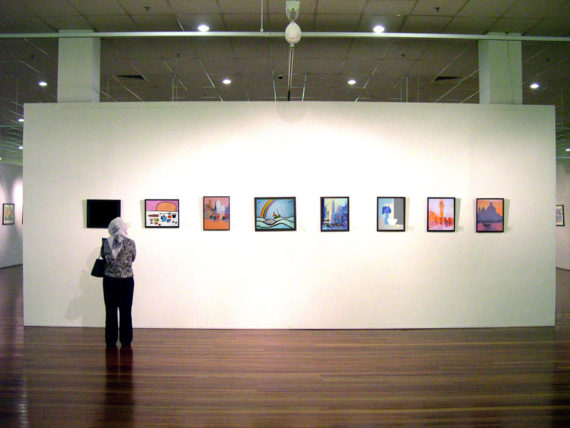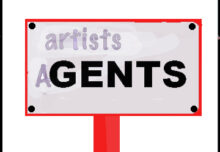COMMERCIAL ART GALLERIES
Here in the UK there are several different sorts of art gallery. Impressive public institutions like the Tate Modern dominate the list. While at the other end of the spectrum are small temporary pop-ups run by artists. In between are the retail commercial art galleries that sell art to the general public. They are run by business people who build up customer contacts and sell on behalf of artists.

commercial art gallery display
There are a handful of London based or international galleries that specialize in prestigious investment art. These high-end galleries often also exhibit at expensive, successful, art fairs. Art fairs are becoming more popular with serious art buyers all over the world. This has meant that we have seen some galleries close their actual retail premises and concentrate on fairs. Meanwhile on the high street other changes are afoot.
Things continue to change.
More widely spread around the UK are commercial art galleries ranging from single owner local art shops to larger chains of publisher/retailer businesses.
Traditionally a small local gallery will sell original artwork and prints that they obtain on a sale or return basis and split any sales income with the artist. 50 – 50 has been quite common. That was in the good old days.
Over the last couple of decades many of the small local commercial art galleries have closed. Instead there has been a rise in well-run, very slick, middle-art galleries in the best locations. These are largely owned and controlled by established fine art publishers. They sell a mixture of original and print edition products. Their artists are often exclusive to the gallery chain.
Also there are more so called ‘vanity galleries’ where the premises are for hire. These come and go and usually do not provide much help for the renter to sell. The artist or group just hire the premises and do all the promotion them-selves. They can rely on passing trade or they can invite collectors from their own existing list of contacts.
Artists choose.
Artists cannot choose to be represented by the high-end galleries. They could choose not to, if ever they were approached. But that approach usually would have happened while the artist was a student at the Royal College. So if that didn’t happen there is very little chance that it ever will.
It is an interesting dilemma for all of the other artists when it comes to where they want to show their work. Does one hire a vanity gallery and do all the work unaided? Or maybe go for one of the small commercial galleries? These are often very friendly but offer small-scale success. So an artist would need to develop good relationships with several to have a chance to survive. But one of the big art-publisher gallery chains would seem to offer a much better chance of success. How tempting, but how to get into them? And is it as good as it seems?
So lets concentrate on the chains for a moment. There are just a few big companies that have multiple branches across the country. These have emerged during the last couple of decades as they have taken over many of the small one-man units. Maybe they survive and thrive because the owners were already into art publishing and had a wider business model and better business acumen. Or maybe they just made, and kept, more of the profit.
Pro’s and cons.
First thing to be mentioned is that it is difficult to attract the interest of the big five fine art publishers. They are swamped by amateur artists who hope to be the next big thing. So the central office will be looking for special factors. A prolific supply of very attractive paintings is probably high on the list. But the images must fit into the companies existing portfolio and not compete with artists who are already signed up.
The images must be the right shape, size and colour range as well as the right subject matter. The artists must demonstrate that they are able to adapt their output to satisfy the galleries customer base. The artist must be media attractive so that they can be wheeled out for promotional events. And the artist must be willing to sign a very tight contract that guarantees the gallery the benefits that they expect to accrue from the partnership agreement.
The artist can do well because they are in the hands of established experienced experts.
The artist will be asked to agree a contract that pays them a percentage of the sales income achieved by the dealer. This is where it can become difficult. As mentioned the gallery chain owners are already art publishers. The artist’s deal will probably be with the parent company of publishers. It might offer a percentage of turnover of the publishing income. But artists must realize that the publishing company will be selling to their own retail section at a very low trade price. The artist might get their percentage of that initial transaction and not on the following sale from the retail gallery to the public. This is why an artist might get a very small percentage of the full retail price of the final, super-quality, framed art-piece.
Horror stories are shared between professional artists about the things that can go wrong. The gallery owners reap turnovers of millions of pounds but payout very small percentages to the actual artist. I recently heard about two million pounds of sales resulting in sixty thousand to the artist. That is three percent!
The gallery will argue that their costs are massive. Property prices, running costs, staff, tax, framing, and return for investors on investment are cited. The artist got sixty grand they might say, how many other artists get that? And if the artist tries to leave the arrangement they will find that their contract forbids them from producing anything that would compete with the gallery portfolio well into the future.
The parent publishing company will expect to obtain access to the complete output of the artist. I have heard stories of publishers who will use their priority access rights to make sure that the artist cannot publish elsewhere. Yes they say, we like your new work, and we want to be able to publish it. So you cannot self-publish, or offer the work anywhere else because our agreement gives us priority. And we choose which images actually get published, not you.
Or go it alone.
An alternative is for the artist to self-publish before or instead of looking for a big publisher. But remember that it is much more difficult to attract the publishers if they cannot have complete control.
And prepare to do all your selling yourself from your website, vanity gallery, open studio exhibitions, or maybe the dwindling supply of retail art galleries that are not controlled by one of the big five.
It will be an uphill struggle.
********************************************************************
Also see Art Biz Secrets Part One by Colin Ruffell on Amazon
And Art Biz Secrets Part Two by Colin Ruffell on Amazon




